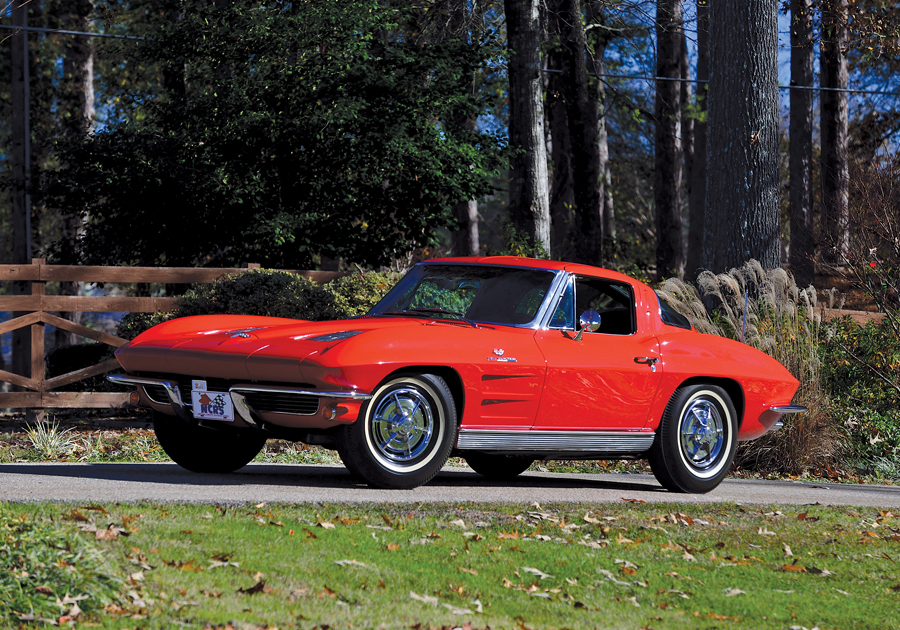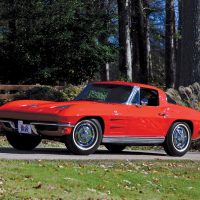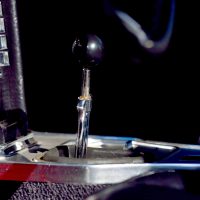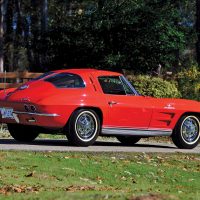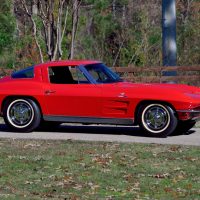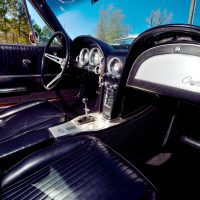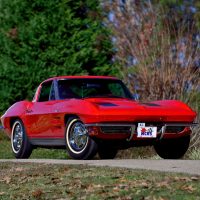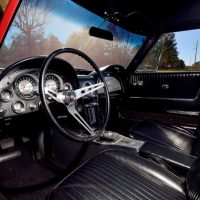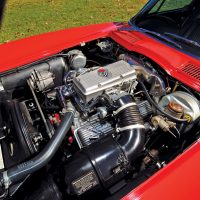- One of the 199 Z06 Corvettes produced in 1963
- Built on May 7, 1963, and delivered to Harry Mann Chevrolet in Los Angeles, CA
- Equipped with the Z06 special-performance equipment option, which included heavy-duty finned metallic brakes, special backing plates, cooling fans, air scoops and heavy-duty suspension, shocks, springs and sway bar
- L84 fuel-injected 327/360 V8 engine
- M20 4-speed transmission and Rochester fuel injection unit
- Power windows and Delco radio
- This car underwent a nut-and-bolt restoration in factory-correct Riverside Red with black interior.
- It has an NCRS Top Flight Award, scoring 99% at the Bend, OR, regional meet, and is listed on the Z06 Small Tank Survey.
- The car comes with a three-ring binder with restoration photos and judging sheets and an NCRS Shipping Data Report and Confirmation of Judging Awards.
- It has been meticulously cared for since the restoration.
SCM Analysis
Detailing
| Vehicle: | 1963 Chevrolet Corvette Z06 |
| Years Produced: | 1963 |
| Number Produced: | 199 Z06 coupes were built, including 63 tanker versions. This car is a small-tank example |
| Original List Price: | $4,252 |
| SCM Valuation: | Median to date, $529,400; high sale, $1,100,000 |
| Tune Up Cost: | $250 |
| Chassis Number Location: | Top of instrument panel at windshield base |
| Engine Number Location: | Pad on front of block below right cylinder head |
| Club Info: | National Corvette Restorers Society |
| Website: | http://www.ncrs.com |
| Alternatives: | 1963–65 Shelby Cobra 289, 1961–62 Jaguar E-type Factory Lightweight, 1971–73 Ferrari 365 GTB/4 Daytona |
| Investment Grade: | A |
This car, Lot F134, sold for $231,000, including buyer’s premium, at Mecum’s sale in Indianapolis, IN, on May 20, 2016.
The Z06 primer
The Chevrolet Corvette Z06, which derives its name from the GM RPO (Regular Production Order) option code (as does the Z/28 and L88) — was a purpose-built, near-track-grade weapon. Gentlemen with a passion for competitive automotive racing were the primary customers.
While the car was intended mainly for track use, more than a few were purchased for swift-moving traffic duties and weekend jaunts. Buyers paid a hefty upcharge, as the Z06 package cranked up the base price from $4,252 to about $5,545 — which was serious money back in 1963.
As with the transformation of the all-new 1956 Corvette, Zora Arkus-Duntov was the driving force behind all things performance with the Corvette — even if that meant butting heads with the guys on the top floor.
Like the 1956 Corvette, the 1963 Corvette was an all-new platform, and Zora found it fitting (and good marketing) to ramp up the machine to compete in world-class competition. He already had many of the performance components, and the 360-horsepower Rochester fuel-injected engine was just the ticket to top it all off.
It was a good plan — with one exception. Carroll Shelby was in the hunt, too, with his Cobras.
Shelby wanted to beat the Corvette — and the imports as well. Shelby didn’t have corporate red tape slowing him down. He could zig and zag while GM was having meetings about labor relations, efficiency reports and which water coolers to put in the main lobby.
Shelby won, GM lost and Zora was given his “Dear John” notice about the Corvette racing program. It was over — which ended the very short-lived 1963 Z06 Corvette and kept the total production to just 199 units.
Low production, high performance
Many of the cars that are now highly prized collectibles weren’t big sellers in period, mostly because they were too expensive or impractical back when they were new. Or, as in the case of our subject car, it was a great car (although expensive) that was torpedoed by the guys who drove their corporate executive Cadillacs home at night. While this was unfortunate back in the day, that phenomenon can mean six- or seven-figure sales today.
A finicky market, but rightfully so
When you start to march up into the nosebleed sales numbers for investment Corvettes, the market can be extraordinarily finicky — and one well-known issue with Corvettes rears its ugly head: Fakes are plentiful.
Bluntly put, vintage Corvettes have nothing to specifically suggest that they were born out of the factory with a specific engine or factory options. Nothing.
While some experts can poke or prod their way through a car and find telltale signs of a stinker, so many of the miscreants (criminals, by my book) have become so superior at their craft of restamping engines, faking paperwork and bolting on various bits and pieces that their creations can pass muster even with the experts.
Corvettes were built on an assembly line, so if a car can be taken apart, it can certainly be put back together to be anything you’d like it to be.
I can assure you right now that there are tons of big-block and Fuelie Corvettes sitting in collections which were born as ordinary, small-block Corvettes. It’s a shame, but it is the sad truth — and a constant topic of discussion among Corvette enthusiasts and collectors.
The numbers get narrower
In a simplified view, all 1963 Z06s are basically the same car — other than the 63 “Tankers,” which have the larger 36.5-gallon fuel tanks. There is a rumor that one Z06 convertible was built, but most experts have ruled that out.
That being said (and tossing out the Tankers), we have 136 1963 Z06s left. Naturally, some of the original 199 Z06 Corvettes have been lost to time, wrecks and other catastrophes, so that final number is even smaller. Some of the cars will only have limited paperwork ,and others may not have even a shred of evidence that they were born as a genuine 1963 Z06.
The trifecta of Corvette valuation
The three 1963 Z06 small-tank car comps in SCM’s Platinum Auction Database include two red examples and one black example. The values range from $159,000 to $267,500. The simplest way to explain the value swing would be based on the condition, but it goes much deeper than that.
By my books (and experience) there are three factors creating value in most Corvettes — or any higher-value collector car. Those factors are condition, documentation and verification. Naturally, rarity and provenance will also drive value as expected — and a great story doesn’t hurt, either. I don’t personally place a lot of value in “numbers-matching” examples because if an assembly-line guy who was hung over from a Sunday night football game party is the same guy stamping motors on Monday morning, well, mistakes will happen — and did happen.
And it’s not all that hard to replicate the stamping. I’ve actually been there as judges talked about the numbers looking “too good” to be the factory stamping.
Out with the old, in with the new
Our new SCM pricing model now includes a median value and the highest sale value noted. The median value is noted as $529,400, with the highest sale at $1,100,000. The main issue with our pricing model for a 1963 Z06 is that the high sale went to a well-known Z06 race car. The other high valuations are for Tankers.
That said, if we narrow down the focus to the small-tank cars, our highest sale comes in at $267,500, which occurred at the Mecum sale in Dallas, TX, in 2013 (SCM# 227411). If we were to deduce a median value range based only on sold “small-tank” Z06 Corvettes in our database, the number comes in at $180,363. And, with that, our subject car’s sales price is squarely in the proper median trading range for a well-documented (genuine) 1963 Z06 Corvette.
A real-deal Z06
As we filter down the data, we can now easily see that on the low end, you might locate a tattered Z06 with sketchy paperwork in the very low $100k range.
On the higher end of the spectrum, a concours-grade example with all the right paperwork might shift up to $300,000 (or more) on a very good day at the right auction venue.
Keep in mind that there will always be special examples with race history — or that are showfield ready with “Day One” paperwork that can boost a car up the Corvette hierarchy even further.
Our subject car remains in very good condition and it garnered a 99% score to earn NCRS Top Flight honors in a Bend, OR, regional meet. The paperwork has also been verified. The car also comes with extensive restoration photos and the judging sheets. The color combination is predictable, but it carries no loss in value.
The seller of the car was known for being very meticulous about his collection — and he did plenty of research to verify what he owned and to document those details.
At the end of the day, what we have is a tidy example with good, — but not exceptional — paperwork. The car was presented with an older restoration that remains in very nice condition. This is a genuine Z06 that can be carefully exercised on fair-weather days and will be met with cheers at any Corvette meet in the country. Well bought and well sold. ♦
(Introductory description courtesy of Mecum Auctions.)
